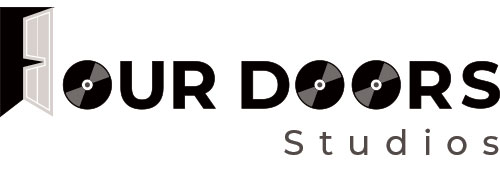What is mixing? Well I’m not talking about mixing a cake, although that does sound tasty! Mixing is the combining of all individual tracks on a song and enhancing each track in the song with digital or analog processing like compression, eq, reverb etc. These tracks are also balanced to get the right levels between all instruments and vocals to make it sound as professional as possible. There are many other effects used when mixing for example; chorus, delay, distortion, saturation, panning, automation etc. So as you can see, mixing is not just about adjusting volume levels, there are many other techniques to making a mix sound great. Some other techniques used include stereo widening, micro-shifting and the Haas effect. I won’t go into detail on all these techniques right now but I do want to give you some of the insights we’ve had along the way here at Four Doors Studios. Below are our top 5 mixing tips. We hope these tips help some producers out there on their audio journey!
- Trust Your Ears Over Aything Else – A lot of mix engineers starting out can easily be overwhelmed with all the different options you have and the endless amount of technology you have at your fingertips. It’s easy to fall into the trap of apply a bit of eq or reverb or compression just because you think you should but then all of a sudden….the instrument your enhancing sounds worse! Always trust your ears! If it sounds good without EQ or without something else that’s ok. Trust your ears as opposed to what you think needs to happen to that instrument to make it sound good. Quite often with mixing the old saying ‘Less is more’ is a very helpful one.
- Avoid Over Processing – This tip is connected with tip 1. A lot of beginner mix engineers will be caught out on this one. We’ve all been there. With the huge array of plugins and virtual instruments we now have access to, it gives us an unlimited amount of different processing options when mixing. With this in mind, be cautious not to apply too many plugins on a channel strip for example. Many great sounds can be achieved with only 2 plugins on a track provided the source of the track or sample has been recorded well. With too many plugins it can have a negative impact on the sound of the instrument being treated.
- Less is more – When mixing we want to use all of these excellent mix tools we have at our disposal. There are some excellent options with regard to cool outboard gear and plugins to use but beware they don’t need too much to make your music sound amazing. Be subtle with how you mix, for example when using eq, make cuts or boosts of 3-5db at most, when compressing you don’t need to completely slam it every time, some subtle compression can go a long way too. If you start looking for ways of making your tracks sound great with minimal processing then you will get a much better finished mix.
- Reverbbbbbbbbbbbbb – Reverb is an excellent tool but like all good tools it needs to be the right tool for the right job. There are many different types of reverb and it’s good to work out which ones will sound right for the right instrument or vocal. Once again if this is used in excess then it can be a detriment to the sound of your track. Too much reverb on a lead vocal track will make the vocals sound too far back in the mix. You don’t need much to enhance the sound you are treating. Look at the different decay times for example and see which ones suit each individual track/instrument. Decay times between 1 and 3 seconds are quite useful. A very subtle amount can be handy in a lot of different places throughout your mix.
- Stereo Widening – One major difference we hear in pro mixes and amateur mixes is that the pro mixes have been stereo widened. This is a very important part of mixing if you want to stand out from the crowd. There are many techniques that can be used to help with this, some I mentioned earlier like micro-shifting, the Haas effect and others include, starting your mix in mono (this will help with creating wider mix all round), utilising different reverbs to create a more multi dimensional sound, panning for width and double tracking. All these techniques are well worth researching and studying if you want to achieve a professional mix.
These are only 5 Tips we have put down but don’t forget other essential tips like: – Checking for frequencies that are clashing and – always check your mixes on multiple devices to make sure it sounds great on all of them before you have finished. So the list goes on but don’t stop researching here.
To find more great tips on mixing head here.
That’s our top 5 mixing tips! We hope this helps you on your audio pathway!
Thank’s so much for reading our blog. If you’d like to book a mixing class or a recording session or have your songs mixed by Simon Paparo please email: simon@fourdoorsstudios.com.au
To hear a list of songs we have mixed at Four Doors Studios click here.
To learn more about the services offered by Simon Paparo at Four Doors Studios click here.


Recent Comments